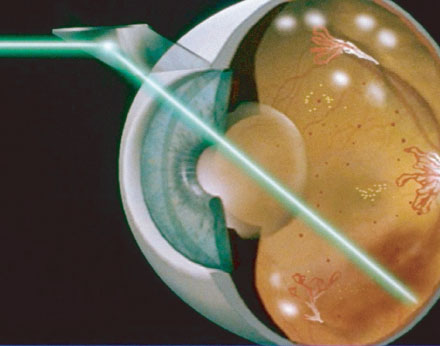Laser treatment is the procedure to correct retinopathy and is done as an outpatient procedure. Suitable drops are used to anesthetise the eye after which a contact lens is placed. A laser slit lamp similar to the machine as that used for the regular examination is used. A Laser which is a highly focused and powerful light in very short bursts is used.
The commonest laser used is Argon Green that has a wavelength of 530nm, but other wavelengths can be used and most are equally effective.
Procedure:
About 1200 burns of the laser is applied through a slit lamp in the clinic. More than this per session may cause inflammation of the eye, and too little too little an effect.
The side or 'peripheral' retina is lasered, not the centre; this is the main difference of laser for proliferative retinopathy as opposed to maculopathy above). The downside of this treatment includes the discomfort. At first the treatment sessions are unpleasant, with stinging flashes. After the laser your sight may be blurred, and the eye may ache for days after the treatment. If the eye still aches after a week, anti-inflammatory drops may be helpful. After the laser some people notice spots in their side vision if they look at anything with a white background. This fades (you are 'seeing' the tiny burns). Other people notice flashes of light at night. Laser is need to stop the new vessels growing, but it does affect your sight. You may notice glare, that is difficulty seeing in sunlight. You may also notice difficulty seeing and driving at night. These are particular problems everyone who has had a lot of laser notices. Wearing a peaked hat may be helpful, as may tinted glasses, or glasses that change colour in bright weather.

As time goes on and more laser sessions are needed, the treatment can become extremely painful. There is no entirely effective way of reducing all the pain, except a general anaesthetic. Local anaesthetic injections in the operating theatre, or tablets that aid relaxation, may help a little. Sometimes the local anaesthetic injection takes away all the pain, sometimes it just reduces the pain slightly. The injection is not into the eye, but under it, at one side. For patients where the treatment is extremely painful larger departments offer general anaesthetics, as these also have the advantage of allowing laser treatment to both eyes. To do this the department must have a laser that can be used in an operating theatre.
The 'up' side of this laser is that the treatment nearly always works, although several treatments may be needed, and further treatments may be needed over the following months and years. An individual laser session only has a very marginal effect on vision.
A 30 year old person with a lot of new vessels may need 6000 laser burns per eye, or even more, to prevent the new vessels growing. Other people usually need less. In patients with very severe disease so much laser may be required that the side vision becomes poor and driving unsafe: the aim of the treatment is to keep good central sight, that is sight looking straight ahead, which is need to read, work, and watch television.
If the proliferation is very aggressive, intravitreal avastin can be used, in addition to laser. It always shrinks the new vessels, but unless there has been a lot of laser treatment given, the new vessels always recur. We are learning how to use this and other anti-VEGF treatment, and each ophthalmologist uses it differently.
Without laser proliferative retinopathy is often blinding, so both patients and doctors may be left with little alternative to enduring and carrying out this often unpleasant treatment. Again, control of diabetes as for maculopathy above is very helpful where possible in the long term. In the short term, improving control from mediocre (say HbA1c 9%) to good (say (6.5%) may encourage unexpected growth of the new vessels, needing laser.However, the improved control is still needed in the long term, and most people are advised to achieve good control even if that means extra laser in the next 2 years, because in the longer term (after 2-3 years) research has shown good control reduces eye and other problems.
About Eye
Eye Diseases
Vision problems
Find Cost
Surgeries & Treatments
Best Eye Hospitals
Testimonials
Get Free Quotes
Top Hospitals In India
Top Hospitals In Turkey
Top Hospitals In Mexico
Top Hospitals In Costa Rica
Top Hospitals In Singapore
Top Hospitals In UAE
Top Hospitals In Australia
Top Hospitals In Malaysia
Top Hospitals In Thailand
Top Hospitals In Phillipines